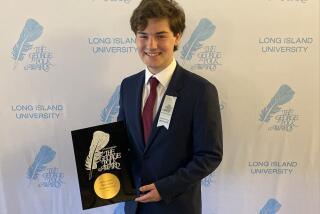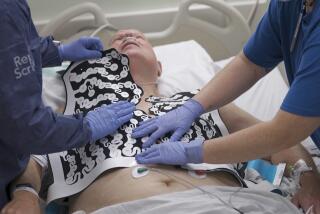Cancer-Treatment Theory an Enigma to Scientific World
‘It’s not my fault it’s complex. . . . People say it’s controversial because it’s another way to say they don’t understand.’
--Dr. Bjorn Nordenstrom
A prominent Swedish radiologist who claims to have discovered a new, electrically controlled circulatory system in the body and to have caused malignant tumors to disappear by passing an electric current through them is emerging as one of the major enigmas in cancer science.
Dr. Bjorn Nordenstrom of Stockholm’s Karolinska Institute (the medical center that picks winners of the Nobel Prize for medicine) suggests evidence for a discovery so dramatic it could completely alter the perception of how body physiology works and provide a cancer treatment that might give hope to the hopeless.
Little Documentation
While many respected experts are fascinated by Nordenstrom’s premise, there is a major problem with his work, too. He has avoided disseminating his results or descriptions of his methods through the usual research channels, thwarting one of science’s safeguards against inaccuracy.
Nordenstrom says he has discovered that blood vessels may act as electrical cables that govern tissue behavior, forming circuits that make it possible for all types of body chemistry to exist and influence tissue. He calls the system one of “biologically closed electrical circuits.”
The electrical properties he has identified, he says, can be manipulated for, among other things, the treatment of cancer--so far, of types confined to the lung and breast but possibly pancreatic and other forms, as well.
If it is valid, the theory establishes the existence of a circulatory system never before imagined and--according even to many scientists overtly skeptical of Nordenstrom’s work--would explain many heretofore mysterious phenomena in the body. Assuming the accuracy of what he says, “breakthrough” fails to adequately describe what Nordenstrom has achieved, many experts agree.
Professional Concern and Doubt
Balancing this, though, is concern and doubt by researchers on two continents about Nordenstrom’s methods for spreading word of his theories--techniques that run counter to Nordenstrom’s long-established adherence to accepted scientific method.
In the process, he has made it all but impossible for many scientists who would like to understand and confirm his work to do so. Nordenstrom contends that he has been too busy with his work to describe it in appropriate scientific publications and that what he is doing is too complex for many of his colleagues to comprehend.
The situation is exacerbated by the fact that Nordenstrom, 66, has already begun treating advanced cancer patients with his new method--a step many colleagues contend may be premature and even unwise. Of the first 20 patients who were treated, 13 died, but Nordenstrom says about 50% of a larger group of about 100 patients are still alive.
In the reactions of his colleagues there is as much frustration over what is almost a scientific tease--the sweeping implications of the theoretical possibility that Nordenstrom is right--as there is over his so far consistent refusal to discuss his work in the normal way.
Confounding these concerns is the fact that Nordenstrom came to the United States last week for appearances at UCLA and at New York’s renowned Memorial Sloan-Kettering Cancer Center--but also to gain media exposure for his ideas.
Dr. Gregory Curt, deputy director of the National Cancer Institute’s division of cancer treatment, shares the concern of many experts watching the Nordenstrom situation. “There is nothing in science that is unique to one man,” said Curt, “and nothing in science that cannot be reproduced by others.”
So to Curt, Nordenstrom’s work represents something that might be intriguing but that remains a mystery. “The theory sounds flawed,” Curt said. “Based on what we know about cancer biology, there is no evidence that changing electrical fields have any impact on a tumor.”
Until now, the only place Nordenstrom has detailed his methods and theories is a book he had printed and is distributing himself because no publishing house would accept it. About 700 copies have been sold, Nordenstrom told The Times last week.
“It’s not my fault it’s complex,” Nordenstrom said. “It’s not my fault that people don’t understand. This is not the first time in history that this situation has occurred. People say it’s controversial because it’s another way to say they don’t understand.”
“I found it just fascinating, but it is wild-eyed,” said Dr. Morton Glickman, a professor of radiology at Yale University School of Medicine who reviewed Nordenstrom’s book last year for a leading journal, Investigative Radiology. Glickman said he approached the work skeptically and is still bothered by Nordenstrom’s refusal to conform to scientific norms that would make it possible for colleagues to verify what he says.
“It (Nordenstrom’s theories) doesn’t follow the usual medical logic but it fits in with a number of scientific facts in many disciplines,” Glickman said. “My feeling is there is a very good chance that it will (turn out to be) true. (But) at this point, I don’t think anybody--perhaps not even Dr. Nordenstrom--would be willing at this point to say (unequivocally) that it is accurate.”
Glickman said this process of attempting to independently corroborate Nordenstrom’s theories may be starting. He said Yale is considering establishing just such a program. At Memorial Sloan-Kettering, Dr. Luis Linares said a study is being considered to evaluate the similarities of the theories Nordenstrom has developed and techniques under separate investigation of the tumor-healing capabilities of controlled heat treatment.
“Very few of us have been able to witness his results,” said Linares of Nordenstrom. “But I think he is a respectable man. He has some fascinating theories.”
Nordenstrom’s work and his methods of describing it have landed leading radiologists and cancer experts in an uncomfortable--and, many of them protest, unnecessary--dilemma: A colleague of renown, working at a medical center whose reputation is beyond reproach, develops a bizarre theory, nevertheless of breakthrough potential, and then fails to make use of established, reliable means to disseminate his ideas.
Theory’s Beginnings
The story begins in Sweden 30 years ago. Nordenstrom had already developed a technique--now accepted worldwide--for recovering biopsy specimens by use of needles inserted deep into the body. His work also included important research on use of injected radioactive dye to permit precise, clear X-ray images of the moving heart.
Seeking to explain why he observed light patterns (eventually, he called them coronas ) around tumors he had observed in X-rays of cancer patients, Nordenstrom began to investigate the electrical properties of blood and body tissue of various types. He found marked electrical differences between dead tissue; healthy, living tissue, and cancerous tumors.
Moreover, the electrical resistence of the walls of blood vessels turned out to be 200 times that of blood. It suggested to him, Nordenstrom told The Times, that the circulatory system may serve as a network of electrical cables--with the vessels functioning as insulation and the blood as metal wire--that deliver current that can govern the absorption of chemicals by tissue of all sorts. Electrical variations of as little as 1 1/2 volts, Nordenstrom said, may profoundly alter tissue behavior.
And if that is true, Nordenstrom said, then it should be possible to influence such things as wound healing and the progress of cancerous lesions by altering electrical fields in such tissue.
“This was a completely new concept,” Nordenstrom said. “It leads to dramatic possibilities.”
By 1978, Nordenstrom--working essentially alone in a laboratory at the Karolinska Institute--had progressed, he says now, to the point where he could apply the knowledge to medical practice.
The technique Nordenstrom developed borrows on his earlier development of long biopsy needles, turning the needles into electrodes that can be thrust through body cavities into a tumor. Later that year, he tried the treatment on his first patient, a 66-year-old woman with massively disseminated ovarian cancer that had spread to her lungs. The technique also has some elements first theorized by earlier researchers as early as 1908.
To treat cancer, Nordenstrom positions a negatively charged electrode needle in a tumor and a second, positively charged, needle in health tissue nearby. Then he passes a 10-volt direct current between the two needles for as long as several hours. The treatment is repeated every few days for as long as several months.
The first patient died, but Nordenstrom says X-rays established the tumor he was treating had nevertheless disappeared. Drawing from among patients who, he told The Times, have been rejected by surgeons and other physicians as having cancer too advanced to be treated, Nordenstrom then treated a group of 20 patients between 1978 and 1981. They had a total of 26 tumors, 14 of which shrank or disappeared as a result of the treatments, he says. Thirteen of the patients died.
But while this initial group of patients produced results that are comparable to survival figures for the earliest days of many established cancer treatments, said Dr. John Austin, an associate professor of radiology at the Columbia University College of Physicians and Surgeons in New York, Nordenstrom has failed to submit details of the cases for publication in any leading medical journal.
The outcomes of the total of 100 or so patients treated now are even harder to scrutinize. Nordenstrom has published not even a brief summary of those results and said it may be two years or more before he is ready to do so.
Helping Relieve Pain
In the interview, Nordenstrom said experience with the 100 patients has also suggested his treatment method may have the side effect of markedly diminishing the pain of many advanced cancers and that, furthermore, his concept of electric circuits in the body could explain why acupuncture seems to work--a step that would make it theoretically possible to revolutionize pain relief.
This aspect of the work, however, is even less far along than tumor treatment, Nordenstrom said.
Nordenstrom did publish a short description of the first 20 cases in 1984 in the Journal of Bioelectricity --an article that remains the only occasion on which he has presented his work in the conventional medical literature. Especially in a field as emotionally charged as cancer research, noted the National Cancer Institute’s Curt, the existing network of established scientific publications offers perhaps the most important safeguard in science.
“It is very easy for the basic part of Nordenstrom’s work not to be known by cancer biologists,” said Curt. “What is uncertain here is how somebody could treat patients and not have published the kinds of articles in biological journals that would have gotten him to be known. There should not be someone offering a treatment (like this) who has not published in the kinds of journals doctors would read.”
Reputable journals employ panels of experts to review articles submitted for publication and the reviewers often find discrepancies and errors in studies that eluded even the best-intentioned scientists. The publication process also makes it more difficult for a scientist to overlook errors in his own work--most often when the errors are unintentional and occur only because of a researcher’s understandable enthusiasm for and preoccupation with it.
Austin said that Nordenstrom has created a credibility problem for himself by avoiding established channels.
“He has made clinical and experimental observations which strongly suggest an entire new theory about the role of electricity in biology and, specifically, in human beings,” said Austin of Nordenstrom.
“Dr. Nordenstrom may be right and he may be wrong,” said Austin. “Nobody knows yet, but it’s a brilliant hypothesis. What he needs to do to convince all of us--and I’m sympathetic to the man’s work--is carefully write up his data.
“As it is, it’s a natural story for sensationalism. (It’s what you would expect to appear in) the National Enquirer. I don’t know what’s going to come of it, but I suspect he’s onto something.”
Skeptical Swedes
Even in Nordenstrom’s homeland, skepticism and concern are rife. “As I see it, you can always find case reports (to support a favored treatment), but they are not scientific documentation, really,” said Dr. Eric Boijsen, an internationally known expert, by telephone from Lund, Sweden.
“You are never (perceived as) a monster in your own country, but I don’t understand what he (Nordenstrom) is doing and he has not documented it systematically in the way we expect him to. He is an extremely good scientist. But (his current work) is very controversial. Nobody really knows what he is doing.”
Dr. Ingemar Ernberg, scientific secretary of the Swedish Cancer Society, was equally guarded. Like Nordenstrom, Ernberg is on the staff of the Karolinska Institute in Stockholm. “His initial series of patients is considered interesting, but people think that his experimental work is not good enough,” said Ernberg. “He has neither proved nor disproved his theories.”
Ernberg emphasized that Nordenstrom’s work is outside Ernberg’s own specialty. But he acknowledged that Nordenstrom has created quite a stir. “The important thing is not (necessarily) what Dr. Nordenstrom does or doesn’t do, but what others can do,” Ernberg said. “This kind of thing must be confirmed independently.”






